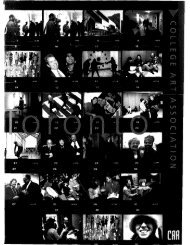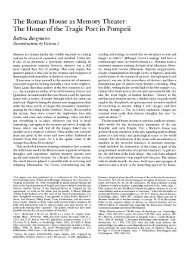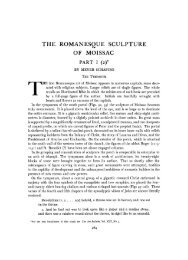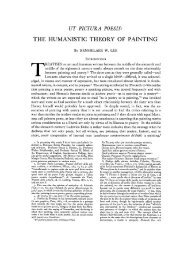Forms of Respect: Alois Riegl's Concept of Attentiveness
Forms of Respect: Alois Riegl's Concept of Attentiveness
Forms of Respect: Alois Riegl's Concept of Attentiveness
You also want an ePaper? Increase the reach of your titles
YUMPU automatically turns print PDFs into web optimized ePapers that Google loves.
286 THE ART BULLETIN JUNE 1989 VOLUME LXXI NUMBER 2<br />
tic element subject to this volition as "the appearance <strong>of</strong><br />
things as form and color in the plane or in space."6 The<br />
system <strong>of</strong> formal analysis constructed on this basis, com-<br />
posed <strong>of</strong> categories <strong>of</strong> perception, became a model for<br />
twentieth-century formal critics.<br />
A year later, however, in Das holliindische Gruppen-<br />
portriit, Riegl turned to an enterprise that, although prob-<br />
ably unknown to Bakhtin, would seem to introduce into<br />
the discourse <strong>of</strong> formal criticism a note as dissonant as that<br />
<strong>of</strong> Bakhtin's dialogism: he began to discuss the artistic role<br />
<strong>of</strong> the beholder. The beholder is most commonly intro-<br />
duced into art-historical literature as a patron or customer.<br />
In this form, the presence <strong>of</strong> the beholder opens art to po-<br />
litical and social, rather than formal, explanations. The<br />
psychological theories <strong>of</strong> E.H. Gombrich and others have<br />
introduced the beholder as an abstract psychological entity.<br />
This psychological beholder, while remaining seemingly<br />
apolitical, threatens the self-enclosed unity <strong>of</strong> the work.7<br />
<strong>Riegl's</strong> introduction <strong>of</strong> the beholder was more straightfor-<br />
wardly formal. He used the literal confrontation <strong>of</strong> the be-<br />
holder and the work <strong>of</strong> art across space as the basis for a<br />
new strategy <strong>of</strong> pictorial analysis. Hence scholars were able<br />
to assimilate <strong>Riegl's</strong> preoccupation with the beholder to his<br />
formal concerns by interpreting his strategy as part <strong>of</strong> an<br />
ingenious method <strong>of</strong> explaining the coherence <strong>of</strong> certain<br />
works <strong>of</strong> art.8 This interpretation, however, has not taken<br />
into account the threat to artistic coherence constituted by<br />
dependence on the beholder.<br />
The present essay proposes a different interpretation <strong>of</strong><br />
<strong>Riegl's</strong> preoccupation with the beholder. I argue here that<br />
Riegl discussed the relationship to the beholder not as the<br />
formal means, but as the ethical purpose <strong>of</strong> art, seeking to<br />
defend the participation <strong>of</strong> the beholder in certain artistic<br />
practices against those who would dismiss it as "theatri-<br />
cality." Then I address the nonformalistic character <strong>of</strong><br />
<strong>Riegl's</strong> "formal" theory, showing it not to be formal in the<br />
hermetic sense, but responsive to the same intellectual chal-<br />
lenge as the theory <strong>of</strong> beholding. Finally, I relate <strong>Riegl's</strong><br />
theory to formal criticism <strong>of</strong> the mid-twentieth century,<br />
with a view to determining whether beholding, any more<br />
6 Riegl, 1901/1927, 19. Stilfragen also contains the term Kunstwollen, but<br />
makes no claim for it as a rigorously defined concept.<br />
7 See esp. E.H. Gombrich, Art and Illusion: A Study in the Psychology<br />
<strong>of</strong> Pictorial Representation, New York, 1960, Pt. 3: "The Beholder's Share."<br />
8 M. Iversen discussed the relation to the beholder in formal terms in<br />
"Style as Structure: <strong>Alois</strong> <strong>Riegl's</strong> Historiography," Art History, Ii, 1979,<br />
62-72; and in her dissertation, "<strong>Alois</strong> <strong>Riegl's</strong> Art Historiography," Uni-<br />
versity <strong>of</strong> Essex, 1979, 101-140; also M. Podro, The Critical Historians<br />
<strong>of</strong> Art, New Haven and London, 1982, 81-95.<br />
9 "Asthetik: Relation der Theile zum Ganzen. Relation der Theile unter-<br />
einander. Hat nicht beruicksichtigt Relation zum Beschauer. Relation zum<br />
Beschauer macht Kunstgeschichte. Gesetzlichkeit darin macht historische<br />
Asthetik"; Riegl, Ms, carton 9, folder 2, unpag. The notes appear to relate<br />
to the manuscript <strong>of</strong> Die historische Grammatik der bildenden Kiinste,<br />
which would date them between 1897 and 1900. For the dating <strong>of</strong> the<br />
manuscript, see Riegl, 1966, 9-11.<br />
10 As will be seen, Spiitrbmische Kunstindustrie treated the relation to the<br />
than dialogism, can subvert formalism, or is fated always<br />
to be coopted by it.<br />
The Attentive Act<br />
Riegl was conscious <strong>of</strong> the consequences <strong>of</strong> the histori-<br />
an's acknowledgement <strong>of</strong> the beholder. In private notes <strong>of</strong><br />
the mid-1890's, he identified the relationship between the<br />
beholder and the work <strong>of</strong> art as the central issue <strong>of</strong> art<br />
history, relegating the analysis <strong>of</strong> the work <strong>of</strong> art in itself<br />
to "aesthetics." "Aesthetics," he wrote, "[is the] relation <strong>of</strong><br />
parts to the whole. [The] relation <strong>of</strong> the parts among them-<br />
selves. [It] has not taken the relation to the beholder into<br />
consideration. The relation to the beholder constitutes art<br />
history. Its general principles make up historical aesthet-<br />
ics."9 If concern for the beholder distinguished history from<br />
philosophy, then Riegl himself was an aesthetician, not an<br />
art historian. Spditrdmische Kunstindustrie, after all,<br />
seemed to treat "aesthetics," the relationship among parts,<br />
not "art history," the relationship to the beholder, even if<br />
it did so historically and relativistically, not in the tradi-<br />
tional philosophical sense.10<br />
If he were an "aesthetician," he may have had good rea-<br />
son. "Art history" is composed <strong>of</strong> the particular facts re-<br />
garding the beholder and the work in historical progres-<br />
sion. "Historical aesthetics" distills these facts into general<br />
principles. The latter term, evocative <strong>of</strong> Hegel, expresses<br />
<strong>Riegl's</strong> tenaciously held view <strong>of</strong> history as a progressive<br />
development. Yet he was unable to detect a difference, let<br />
alone progress, between "classic" and "modern" art in re-<br />
spect to the relation to the beholder. "Both," he wrote, "are<br />
objectivistic. Neither lets the figure look at the beholder.<br />
Rather, things happen independently from the beholder,<br />
not for the beholder's sake."'' Riegl must surely have found<br />
it problematic that the development <strong>of</strong> art was circular in<br />
the respect that he regarded as central to its history.<br />
<strong>Riegl's</strong> studies <strong>of</strong> Dutch art appear to confront this prob-<br />
lem directly. His first attempt to practice "art history," that<br />
is, to trace a development in the relationship between art<br />
and its beholder, was Das holliindische Gruppenportriit<br />
(1902). Whether Riegl projected his own concerns into them<br />
beholder after all, but not in the same sense as did Das holliindische<br />
Gruppenportriit.<br />
11 "Klassische und moderne Kunst: ihre Verwandschaft. Beide sind ob-<br />
jektivistisch. Keine lii~t die Figur den Beschauer fixieren, sondern die Dinge<br />
vollziehen sich unabhangig vom Beschauer, nicht fur die Absicht des Be-<br />
schauers"; Riegl, Ms, carton 9, folder 2, unpag., <strong>Riegl's</strong> emphasis. By "clas-<br />
sic" art, Riegl could have meant either the art <strong>of</strong> Periclean Greece or the<br />
High Renaissance art that his contemporary Heinrich Wolfflin had dis-<br />
cussed in his work, Die klassische Kunst: Eine Einfiihrung in die italien-<br />
ische Renaissance, 1899. If Riegl had the art <strong>of</strong> the High Renaissance in<br />
mind, he was, <strong>of</strong> course, mistaken, since Renaissance altarpieces <strong>of</strong>ten<br />
directly addressed the spectator, or contained intermediary figures invit-<br />
ing the spectator into the work. In the Austria <strong>of</strong> <strong>Riegl's</strong> era, the term<br />
"modern art" was used to signify anything from the Renaissance to the<br />
present time. Riegl probably had in mind a very contemporary image to<br />
be opposed to "classic" art: paintings by Whistler, academic French<br />
Impressionists and their German imitators, realist art by Leibl or Menzel,<br />
and the symbolist work <strong>of</strong> Klinger or Stuck.










